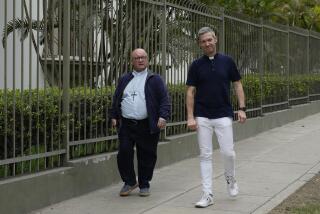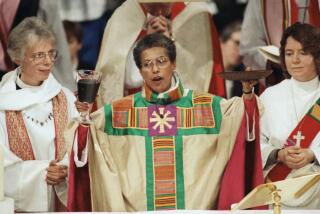Vatican Issues Guidelines on Gay Priests
- Share via
ROME — The Vatican on Tuesday formally released instructions that block actively gay men from the priesthood, a long-anticipated document that already has opened a debate over how it will be applied and whether it will have a healing, or detrimental, effect on the Roman Catholic Church.
Church conservatives are applauding the document for taking a strong stance against what many see as an immoral “gay subculture” within seminaries and church life, and for establishing clearer restrictions on who is suitable to become a priest.
But liberals said they feared the rules would be used to keep qualified men out of a depleted priesthood because of their sexual identity, even when celibate.
This is the first major instruction to be issued by Pope Benedict XVI, and the fact that it focused on homosexuality reflected the German pontiff’s concern over morals he sees being eroded by Western secular culture.
Cardinal Zenon Grocholewski, author of the eight-page document as prefect of the Congregation for Catholic Education, said Tuesday that it was crucial for the church to speak out now.
“Many are defending a position in which the homosexual condition is considered a normal condition of the human being, almost like a third gender,” Grocholewski told Vatican Radio. “That absolutely contradicts human anthropology, and, according to the church, contradicts natural law.”
The document, which was leaked in its entirety last week on a Catholic news website, says that men with “deep-seated homosexual tendencies” or who support a “gay culture” may not become priests. But men who have “overcome” a homosexuality that was “transitory” and who have remained celibate for three years before joining the seminary are eligible.
Father Robert Gahl, a theologian, praised the document for establishing “more challenging expectations” for men who want to become priests. Homosexuals are clearly barred, he said, because the rules require a man with homosexual tendencies not only to have lived a celibate life but to have overcome those tendencies long before entering the seminary.
“Anyone who considers himself homosexual ought to realize that as such, the church is not calling him to the priesthood,” said Gahl, who teaches at Rome’s St. Cross Pontifical University, which is run by the conservative Opus Dei organization.
“The document is strong in that it restates in this time of crisis in the church what has always been the traditional teaching of the church, [that homosexuals] are objectively disordered,” Gahl said. “It screens out candidates who suffer from emotional immaturity, especially in a sexual area.”
But Father Mark R. Francis, superior general of the Rome-based Clerics of St. Viator, said some of the language was so ambiguous that the guidelines would be interpreted and applied differently from diocese to diocese. The document, for example, does not provide definitions of “deep-seated homosexual tendencies” and “transitory” homosexuality.
“There is a question of what the document says, and what good pastoral practice is,” Francis said.
“We have some very good gay priests who are gay in terms of their orientation but who are celibate and chaste,” Francis continued. “If the document is interpreted in a very strict manner, it would be an impoverishment for the church and would exclude excellent people. There will have to be prudential judgment on who is accepted into seminaries.”
Grocholewski, the cardinal, sought to illuminate at least one of these points. He said “transitory” homosexuality referred to acts committed out of youthful curiosity, in a state of inebriation or by a man confined to prison for many years. These were not “deep tendencies” but “transitory circumstances,” and as long as they occurred more than three years before application to the seminary, the person remained eligible for the priesthood.
The debate over the document appears most intense in the United States, where homosexuality in the priesthood has long been openly discussed. Although experts note that homosexuality and pedophelia are not linked, the clergy sexual abuse scandal rocking the U.S. church further highlighted the existence of gay priests because many victims were male.
Vatican officials began work on the document years before the scandal, but its exposure made the guidelines “more urgent,” according to a preamble to the instructions.
George Weigel, a conservative Catholic biographer of the late Pope John Paul II and senior fellow at the Washington-based Ethics and Public Policy Center, said he hoped the document would help foster a “genuine and enduring” reform of the priesthood.
But “that is entirely up to local bishops,” he said in an e-mail response to a request for comment. “... No Roman document (and particularly one that essentially reiterates long-standing Church policy) can substitute for courageous leadership by religious superiors, calling all under their authority to live the ‘more excellent way’ by honoring the majesty of their vows.”
The document states that the ordination of homosexuals can have “negative consequences” because they cannot relate correctly to the men and women in their flock. It says priests must develop a “true sense of spiritual fatherhood for the ecclesiastical community ... entrusted to him.”
Vatican officials said the new guidelines are not meant to suggest removal of priests who are already serving. Church officials also have responded to accusations of discrimination, saying there is no “right” to become a priest. It is a calling, they say, a gift from God.
More to Read
Sign up for Essential California
The most important California stories and recommendations in your inbox every morning.
You may occasionally receive promotional content from the Los Angeles Times.











